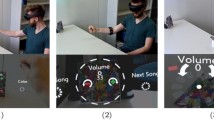Abstract
Networked Surfaces are surfaces which provide networking to specially augmented objects when these objects are physically placed on top of the surface. When an object (e.g., a notebook computer) connects, a handshaking protocol assigns functions such as data or power transmission to the various conducting paths that are established. This paper describes the position occupied by this concept in the world of networking, presents an overview of the technology used in its realisation, describes the current prototype implementation, and outlines the implications in the fields of Ubiquitous and Sentient Computing.
Similar content being viewed by others
References
G.D. Abowd and E.D. Mynatt, Charting past, present, and future research in ubiquitous computing, ACM Transactions on Computer—Human Interaction 7(1) (March 2000) 29–58.
P. Bahl and V.N. Padmanabhan, User location and tracking in an inbuilding radio network, Technical report, Microsoft Research (February 1999).
F. Bennett, D. Clarke, J.B. Evans, A. Hopper, A. Jones and D. Leask, Piconet — embedded mobile networking, IEEE Personal Communications 4(5) (October 1997) 8–15.
Bluetooth, A low-cost short-range radio networking solution, http://www.bluetooth.com/
BLVDS, A high speed multi-drop bus signalling architecture, http://www.national.com/appinfo/lvds/
J.R. Cooperstock, S.S. Fels, W. Buxton and K.C. Smith, Reactive environments, Communications of the ACM 40(9) (September 1997) 65–73.
D.L. de Ipina and S.-L. Lo, Sentient computing for everyone, in: Proceedings of DAIS 2001, IFIP (November 2001).
H.-W. Gellersen, M. Beigl and H. Krull, The MediaCup: Awareness technology embedded in an everyday object, in: The First International Symposium on Handheld and Ubiquitous Computing (HUC99) (1999).
R. Headon and R. Curwen, Recognizing movements from the ground reaction force, in: Workshop on Perceptive User Interfaces (November 15–16, 2001).
A. Hopper, The Clifford Paterson Lecture, 1999, Sentient Computing, Philosophical Transactions of the Royal Society of London 358(1773) (August 2000) 2349–2358.
I2C, A networking solution for integrated circuits, http://www-us2.semiconductors.philips.com/i2c/
IEEE, ANSI/IEEE Standard 802.11 (December 1999).
J.J. Kistler and M. Satyanarayanan, Disconnected operation in the Coda file system, ACM Transactions on Computer Systems 10(1) (1992) 3–25.
A. Kumar, Comparative performance analysis of versions of TCP in a local network with a lossy link, IEEE/ACM Transactions on Networking 6(4) (1998) 485–498.
S. Mann, 'smart Clothing': Wearable multimedia computing and ‘personal imaging’ to restore the technological balance between people and their environments, in: Proceedings of ACM Multimedia'96, ACM (1996).
W. Newman and P. Wellner, A desk supporting computer-based interaction with paper documents, in: Proceedings of CHI'92, ACM (May 1992).
J. Rekimoto and M. Saitoh, Augmented Surfaces: A spatially continuous work space for hybrid computing environments, in: Proceedings of CHI'99, ACM (May 1999).
T. Richardson, Q. Stafford-Fraser, K.R. Wood and A. Hopper, Virtual Network Computing, IEEE Internet Computing 2(1) (February 1998) 33–38.
SmartHome, Networked home products using X10 technology, http://www.smarthome.com/
T. Starner, D. Kirsh and S. Assefa, The Locust Swarm: An environmentally-powered, networkless location and messaging system, in: Proceedings of the International Symposium on Wearable Computing '97, IEEE Computer Society (1997).
R. Want, A. Hopper, V. Falcao and J. Gibbons, The Active Badge location system, ACM Transactions on Information Systems 10(1) (1992) 91–102.
A Ward, A. Jones and A. Hopper, A new location technique for the Active Office, IEEE Personal Communications 4(5) (October 1997) 42–47.
M. Weiser, Some computer science problems in ubiquitous computing, Communications of the ACM 36(7) (July 1993) 75–84.
T.G. Zimmerman, Personal Area Networks: Near-field intrabody communication, IBM Systems Journal 35(3–4) (1996) 609–617.
Author information
Authors and Affiliations
Rights and permissions
About this article
Cite this article
Scott, J., Hoffmann, F., Addlesee, M. et al. Networked Surfaces: A New Concept in Mobile Networking. Mobile Networks and Applications 7, 353–364 (2002). https://doi.org/10.1023/A:1016539632660
Issue Date:
DOI: https://doi.org/10.1023/A:1016539632660




